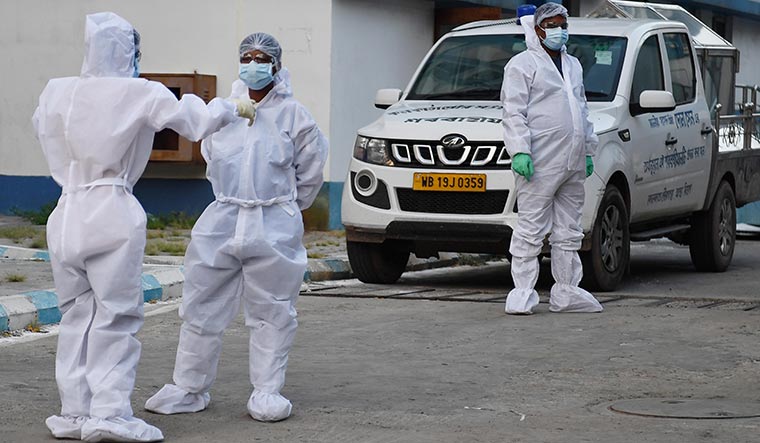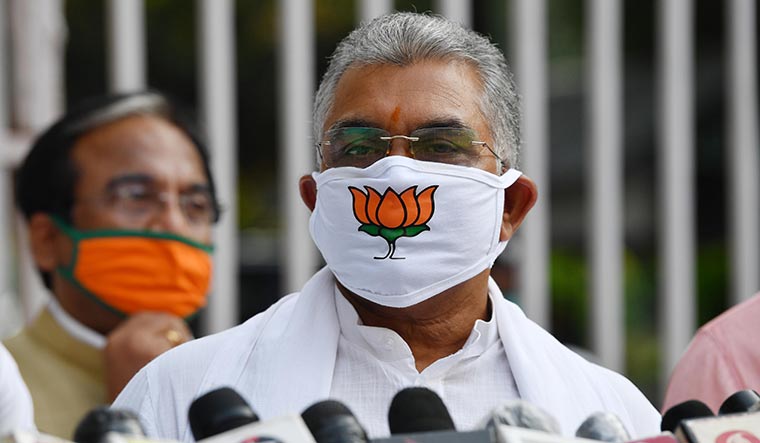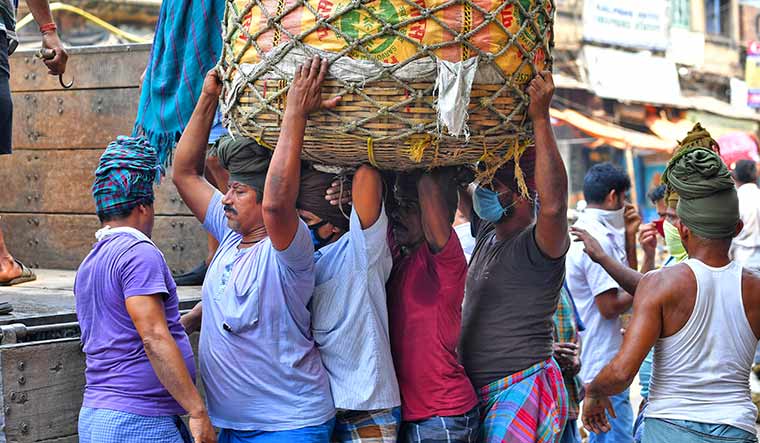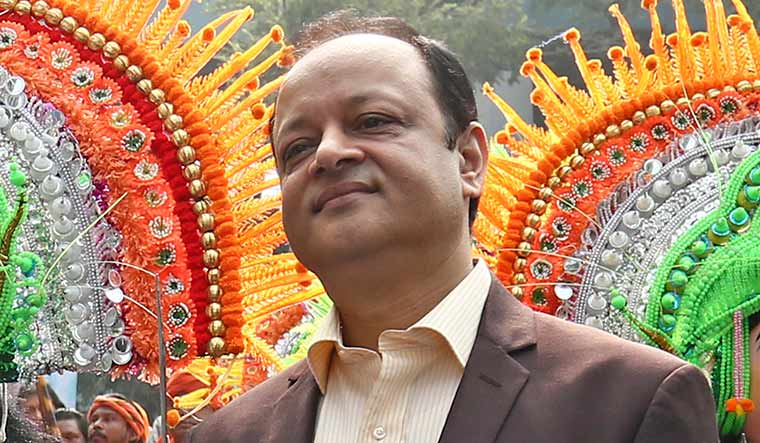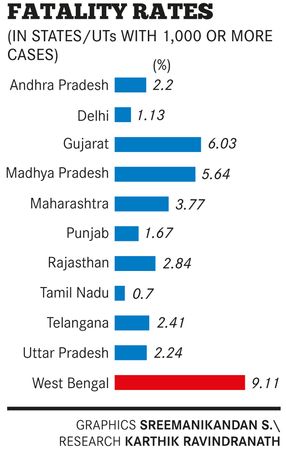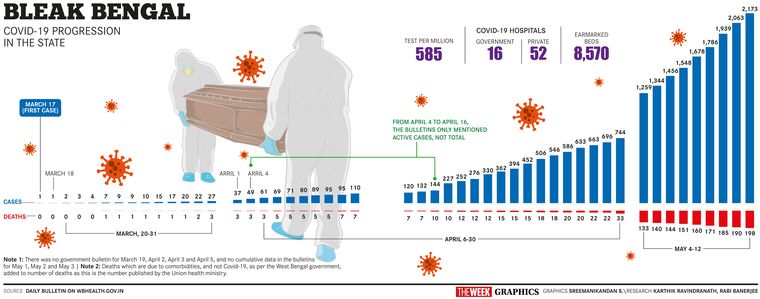On March 19, as Prime Minister Narendra Modi announced a Janata Curfew to tackle the Covid-19 pandemic, West Bengal seemed preoccupied with the Citizenship (Amendment) Act and its attendant politics. Though Chief Minister Mamata Banerjee did not object to Modi’s decision, many shops remained open on March 22, the day of the curfew. The same day, Banerjee declared a lockdown in West Bengal till March 27, signalling that the state would decide on all pandemic-related measures.
At the time, both Banerjee and the state BJP were chalking out plans for next year’s assembly elections. While many BJP leaders were slated to visit the state, Banerjee was preparing to head to north Bengal, where her party was routed in the 2019 Lok Sabha elections. She was banking on the anti-CAA sentiment in the state, and her new strategist, Prashant Kishor, was keenly monitoring the situation.
Elsewhere, a storm was brewing. As Covid-19 cases started increasing in March, many factories across the country began releasing workers and shutting down. Amid the panic and chaos, a large number of Bengalis had to return home. “There was no way I could stay there (Kerala),” said Tofajjal Sheikh, a young man from Lalgola in Murshidabad. “I was working in an agro-farm near Kasargod. My employer asked me to go back home as many other employees were also running a fever. I came to Lalgola on March 12.”
Thousands of others also returned, but medical checks at the stations were reportedly lax.
“I was alarmed to see how migrants were treated,” virologist Amitava Nandy told THE WEEK. “They were all coming from highly infected zones and were released after being given hydroxychloroquine (HCQ). This is absurd and unimaginable. HCQ has no role at the pre-exposure level. Even in full-blown patients, it does not kill the virus but only reduces symptoms. They should have been sent for institutionalised quarantine.”
Hundreds of students from Rajasthan, Kerala and Maharashtra, who returned in buses and trains, were also given HCQ and allowed to go home to various parts of the state.
“We are unable to track the virus because the way it is mutating is alarming,” said Nandy. “It has a certain character in one place, but just 5km away, it is mutating in such a way that the old antibodies fail to tackle it.”
When the Modi government first extended the lockdown till April 30, Banerjee said her state would also do so, but with a human face. Bengal kept open markets and gave relaxations to labour-intensive sectors like tea and jute. However, people violated social distancing norms in these places, which could have worsened the situation in the state.
Bengal was also reportedly late in tracking down those who had attended the Tablighi Jamaat event in Delhi, which later became a Covid-19 hotspot. According to news reports, the state began identifying the attendees only on March 31, nearly 10 days after the event had ended.
A large number of people from Kolkata, Howrah, South 24 Parganas, Hooghly, North 24 Parganas, Malda and Murshidabad had gone to the Tablighi markaz (centre). The Bengal government, however, officially detected only 73 attendees, who came to it voluntarily. “If Assam could detect 500 cases within three days and altogether 800 cases, why could the Bengal government not go beyond 73?” asked state BJP president Dilip Ghosh. “Apart from migration, the Tablighi returnees are the major reason for infections in the rural belt. The government knew it and did nothing.”
But there were also some who supported Banerjee. “The chief minister dealt with the Tablighi issue correctly,” said Syed Zamirul Hasan, state president of the All India Majlis-e-Ittehadul Muslimeen. “They (Tablighis) are known for their cleanliness. It is a pity that the Centre and many other governments gave them a bad name and ill-treated them.”
Nevertheless, people living in certain parts of central Kolkata like Park Circus and Taltala—where many Tablighi Jamaat followers from Uttar Pradesh and Bihar are said to be staying—told THE WEEK that they saw many bodies being taken out from their areas recently.
Shehanshah Jahangir, former Indian Union Muslim League national secretary and businessman, said he was also told about bodies taken to various burial grounds in Kolkata. “Not only Muslims, but many Hindus also died in the past one month,” he said. “They might have died of other diseases, but the way they were cremated and buried by the police and sanitation workers wearing PPE (personal protective equipment) raised a lot of suspicion.”
According to sources, the Pragati Maidan police station in eastern Kolkata was entrusted with organising a mass funeral at the Dhapa landfill, one of the biggest dumping grounds in India. The officer in charge of the police station, along with a few others, was infected and hospitalised.
On April 21, Sisir Naskar, superintendent of the government-run M.R. Bangur Hospital in Howrah, reportedly wrote to the Jadavpur police station, saying that bodies needed to be removed as the mortuary was full. State government sources said Naskar has been asked to explain why he wrote such a letter.
Kolkata apart, there have been reports of the police cremating bodies in Alipurduar district in north Bengal. Officially, the district has no cases. However, on April 20, the police and villagers clashed in a village in the district after locals tried to stop the cremation there. The police had been wearing PPE and the families of those cremated were later told to remain home. “If these were natural deaths, why were families asked to be quarantined?”asked state BJP vice president Biswapriya Roychowdhury.
Another problem plaguing Bengal is that the doctors are scared of treating the patients. In Howrah, the superintendent of the district hospital was infected, along with some other doctors and nurses, forcing the facility to close temporarily. At least half a dozen doctors in Kolkata have also been infected, and two have died. According to news reports, the West Bengal Doctors Forum has written to Chief Secretary Rajiva Sinha about the rising number of infections among health workers in the state.
As of now, the cases seem to be largely confined to south Bengal. But if the virus spreads in the northern parts, it would spell doom for the state. Of 68 Covid-19 hospitals in the state, north Bengal has only 10, that too for nearly two crore people.
“I have no doubt that it has now become community infection,” said Nandy. “There are hundreds of cases where we have not found any source of contamination. We need to follow a roadmap to tackle the spread. We are completely in a mess thanks to a lack of decisions at the top.”
The 10 Covid-19 hospitals in north Bengal are small nursing homes with very few beds. In Darjeeling district, only six private hospitals (no government facilities) have been allowed to treat Covid-19 patients; the district has had two deaths already, one in Siliguri and the other in Kalimpong.
The total number of beds in these six hospitals is 525, catering to 20 lakh people. The North Bengal Medical College and Hospital, the biggest state-run hospital in the region, did not have the facilities to tackle the pandemic.
Together, the 10 private hospitals in north Bengal have 67 ventilators. The whole state, according to the government, has 392 ventilators for Covid-19 cases. “Only 31 have been used so far,” said Home Secretary Alapan Bandyopadhyay, trying to project confidence.
One reason West Bengal has suffered during the pandemic is the lack of private investment in the health sector. “No health care investment took place in Bengal in the past one decade,” said Darjeeling MP Raju Bista. “The situation in north Bengal is grimmer than in Kolkata. There is no big hospital to cater to two crore people, and there are no ICUs in hospitals.”
On April 3, the government set up an audit committee to ascertain if patients had died of Covid-19. Curiously, victims who had co-morbidities were not listed as having died of Covid-19. “This is a human rights violation,” said Bista. “Nowhere in the world have the powers of doctors been curtailed in such a way. It is a violation of the code of medical ethics and practice.”
While the media reported more deaths in the following days, the official number remained low. In fact, even before the audit committee was formed, the state kept altering the format of the daily bulletins, adding and removing information and causing confusion.
On April 20, the Union government sent Inter-Ministerial Central Teams to Bengal to assess the situation. A few days later, the teams from Delhi sought details of the working of the audit committee.
The two IMCT teams were initially not allowed to move around freely. Noted the team led by Special Secretary Apurva Chandra: “The state government has taken an antagonistic view to the IMCT and has not supported the IMCT in performing its duties. This is in contrast with the experience of the IMCTs deputed to other states, where daily schedules of the visits were prepared and meetings were held by the IMCTs with the highest levels of the government to the field-level functionaries.”
The IMCT teams also found gaps in the state’s pandemic data and said that the Covid-19 mortality rate in West Bengal (9.2 per cent on May 12) was the highest in the country.
The Central teams were apparently denied information on the Tablighi Jamaat markaz attendees and they were not given appointments with senior state officials. “Except the principal secretary, health, whom we spoke with through video conference, no one was available,” said Chandra.
Said State Education Minister Partha Chatterjee: “If the intention was to assist the states, they would have sent teams to Gujarat and Haryana before West Bengal. In February, over one lakh people were packed in a stadium for the Namaste Trump event in Ahmedabad. Can the Centre guarantee that there was no transmission of Covid-19 in that event and there weren’t attendees from Bengal who possibly carried the virus back to the state?”
After the IMCT teams pulled up the state government, the latter has been more forthcoming with the information. On May 11, the government put the number of Covid deaths at 118, a dramatic increase in the number (18) it had claimed on April 24. The number of deaths due to comorbidities was 72 on May 11.
On May 12, in the face of mounting criticism, state health secretary Vivek Kumar was transferred to the environment department. Also, the death audit committee would now study only select Covid-19 deaths. Said Dr Sukumar Mukherjee, the chief minister’s health adviser: “The government has decided to retain the committee. I am not part of it and have nothing to say about it.”
BJP leader Roychowdhury saw politics behind the formation of the committee. He alleged that the ruling Trinamool Congress wanted to use the pandemic as a political tool.
There has also been criticism of the low testing in the state. Till May 11, Bengal had tested 47,615 samples, which is 529 per million people. Till mid-April, the state was testing only 400 samples a day. This is now around 4,000.
Chandrima Bhattacharya, West Bengal junior health minister, blamed the faulty kits and the Indian Council of Medical Research guidelines for the low testing. “If the ICMR fixes [parameters for] who can be tested and under what circumstances, what could we do? Also, we got faulty kits that had to be returned. It is too bad that they (the BJP) are playing politics over it.”
Countered Roychowdhury: “If we had to do politics, why should we not target Kerala, Delhi and Rajasthan? They took initiative and bought test kits. This government sat idle because it wanted to blame the Centre.”
The state-Centre clash did not stop there. Recently, as the Railways decided to run trains carrying migrant workers, the Union home ministry asked the states to submit a report on the number of migrants they had.
West Bengal, apparently, did not answer. The home ministry mailed another letter to the chief secretary, which also went unanswered. Home Minister Amit Shah then shot off a letter criticising the Bengal government.
While Trinamool Rajya Sabha member Derek O’Brien said it was in Shah’s “DNA to play politics [even] during a pandemic”, no one from the government explained why there was no reply to the home ministry’s letters.
Sources in the state administration said that Banerjee was initially reluctant to accept migrants from red zones. “She herself decided to bring people stuck in green and orange zones but the situation would have turned serious if red zones were given priority,” said a state official.
The Centre, however, was unfazed, and went ahead with its plans.
The medical side of the pandemic aside, sources said Banerjee was extremely upset at the Centre’s handling of the economy, especially the impact of the lockdown on the states. GST collection would be affected because of the lockdown and states would have to rely on Central grants.
On April 8, the Centre announced that states would be allowed to borrow a cumulative of Rs3.20 lakh crore from the market between April and December. Of this, West Bengal would get around Rs20,000 crore, which the state government says is not enough.
On May 11, during Modi’s video-conference with the chief ministers, Banerjee said that the states should be allowed in the discussion before the Centre takes any decision. “My only humble request is, do not bulldoze the federal structure,” she said.
Asked about the politics surrounding the pandemic, virologist Nandy said, “I would only urge the politicians and everyone else not to damage the science and allow it to propel [research]. We have serious days ahead of us.”
He said the major mistake India had made was not having a single policy across states. He said the Centre should have first shortlisted Covid-19 cases in different parts of the country, and then launched massive testing in those particular areas to know whether it was spreading. “Every week, we should have done tests at places where positive cases were reported,” he said. “This should have continued for a few weeks. Only then would the government know how long a lockdown was required. Nothing like that has been done; the states and the Centre kept fighting in these critical hours.”



